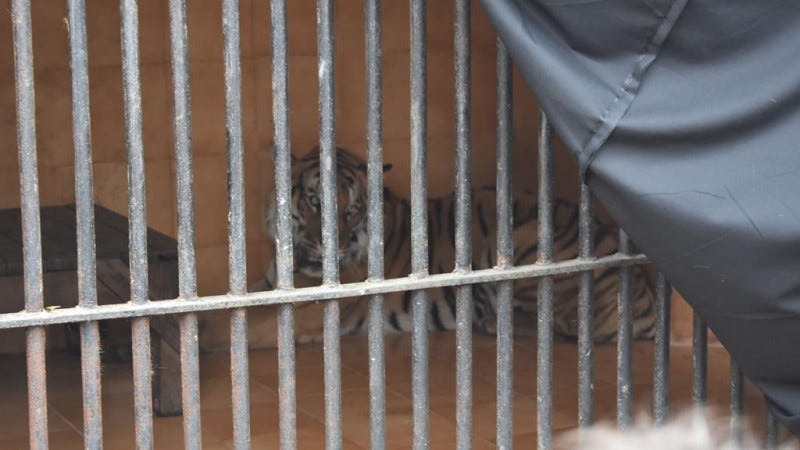On Human-Tiger Conflict: An Encounter with the Striped Kind
On June 6th, 2022, Asmita Tharu, a 41-year old native of Bardiya district, was attacked by a tiger while she was out gathering firewood in her local community forest. She was rushed to Nepalgunj for treatment but eventually succumbed to her injuries. But Asmita is far from being a unique case of such human-tiger conflict in Nepal. Reports from 2022 show that, on average, tigers had attacked three people per month near national parks and buffer zones over the past three years. These attacks resulted in 62 deaths, with severe injuries occurring in 28 percent of the 104 documented incidents.
Earlier that year, Nepal had triumphantly declared a tripling of its tiger population, a remarkable achievement that captivated the international media. Yet, the link between this success and these unfortunate incidents illustrates the human toll of Nepal's effective tiger conservation efforts. With this substack, written to commemorate World Tiger Day 2023, I aim to highlight this problem and propose some solutions to mitigate these negative consequences.
Tigers: By the Numbers
It is estimated that, at the turn of the 20th century, there were over 100,000 tigers roaming the earth. Within a 100 years, however, this tiger population had declined by an estimated 97%, driven primarily by the loss of their habitat due to rampant deforestation and urbanization. This was also abetted by the popularity of trophy hunting, especially in the past when wealthy maharajas and colonists hunted tigers off the backs of elephants as a symbol of prestige and power. Then there is the rampant poaching and smuggling driven by the high demand for tiger body parts from certain cultures that have also contributed to a drastic decline in global tiger populations, the illicit trade of which continues to challenge global conservation efforts.
Concerns about the dwindling tiger population got louder in the 1970s, when estimates suggested that less than 4,000 tigers remained. Consequently, the governments of affected countries, in cooperation with global organizations, initiated various efforts to prevent this endangered species from becoming extinct. For example, countries began establishing tiger reserves, limiting human interference and allowing the habitat to return to its natural state. Additionally, there were international agreements prohibiting the international trade in tiger parts and products, as well as the introduction and implementation of strong anti-poaching laws. The collective concern culminated in the 2010 Global Tiger Summit in Russia, where the audacious TX2 goal of doubling the wild tiger count by 2022 was announced. Although the goal has not been completely achieved, the International Union for the Conservation of Nature reports 'stable and increasing' tiger numbers worldwide. The most recent figures suggest a significant increase in the tiger population, estimated to be between 3,726 and 5,578—marking a 40% rise from the 2015 estimates.
One country that managed not only to meet its target but to significantly exceed it was Nepal. The nation reported a remarkable tripling of its tiger population on World Tiger Day, July 29th, 2022, boasting 355 tigers compared to 121 in 2010. This success can be attributed to the rigorous conservation efforts of the Nepalese government, the invaluable contributions of various national and international agencies, and the active participation of local communities. With a dozen national parks, five of which are now thriving with tigers, these concerted efforts have also fostered the protection of other species, including elephants, one-horned rhinos, and pangolins.
Of Success and its Challenges
Nepal’s success in tiger conservation is, without a doubt, praiseworthy. But this does come with its own set of challenges. This begins with the obvious question: do our national parks have the capacity and infrastructure to hold all 355 tigers? To answer this, let me show you the math done by Jonathan Augustin in his 2021 article, In Nepal, Doubling Down on Tiger Conservation Looks to Pay Off: An individual tiger requires about 50 square kilometers (km2) of territory and a prey density of around 150 animals per km2. If we were to consider just the 250 tigers, as per the goal set by Nepal, we would need 12,500 km2 of territory. At present, the tiger population is concentrated mainly in the five national parks in Banke, Bardia, Parsa, Chitwan, and Suklaphanta, which cover about 5,200 km2 (including the buffer zones), resulting in only 21 km2 of territory per tiger and a prey density of about 56 animals per km2.
Considering the limited territory, some conservationists have proposed expanding the areas surrounding these parks, which encompass an additional 40,000 square kilometers of forests, grasslands, and agricultural lands, traditionally tiger habitats. However, such a move could further increase human-tiger conflicts, posing a significant challenge. Tigers, especially the old or injured, may seek easier prey, such as cattle. Although attacks on humans are rare, they do occur, often influenced by factors like a lack of natural prey, habitat loss, or disturbance from human activities.
Thoughts on How to Handle a Tiger
Despite these challenges, let me emphasize that it is Nepal's success in tiger conservation that provides the groundwork for creating sustainable strategies. But for this success to be sustained, we must devise strategies that balance the aims of conservation with the welfare of the people that live closest to them. Here, I would like to highlight some of the key ones:
Nepal has seen considerable success with its anti-poaching efforts, a practice that must continue. Furthermore, since Nepal acts as a transit route for illegal tiger products from India to China, this activity requires close monitoring.
Efforts should be made to rehabilitate the tiger's natural habitats and boost the availability of their prey. By doing so, tigers will be less likely to encroach on human settlements, reducing potential human-tiger conflicts.
Implement early warning systems that utilize tracking devices to alert communities of a nearby tiger, enabling them to take necessary precautions. Building electric fences can also serve as an effective deterrent.
Educate local communities about tiger behavior, the importance of conservation, and strategies for mitigating conflicts to decrease hostility and fear. Incorporate communities into conservation efforts to promote a sense of responsibility and ownership.
Put in place timely and fair compensation schemes for people who lose their lives or their animals because of tiger attacks to help reduce economic losses and stop people from killing tigers in retaliation.
Nepal should consider engaging in “tiger diplomacy,” whereby Nepal could send some of its “extra” tigers as diplomatic gifts to enhance its relationships with other countries.
The current strategy for managing rogue tigers involves keeping them caged in captivity. This approach is stressful for the tigers and also costly to maintain, especially with growing human-tiger conflict. It may be necessary to also consider the option of euthanizing some of them.

Concluding Thoughts
It was in my final years of school when I first came across William Blake's poem, which I think vividly captures the aura of a tiger's presence.
“Tyger Tyger, burning bright, in the forest of the night.
What immortal hand or eye could frame thy fearful symmetry?”
But my own encounter with the striped kind, albeit a vicarious one, had been much earlier, as a young kid reading voraciously through the chronicles of hunter-turned-conservationists like Jim Corbett and Kenneth Anderson. I still recall the fear I felt as I devoured each page. But for many Nepalis, the need to cohabit with these formidable predators is not a work of fiction but an increasingly daunting reality. “It’s a small world after all…” and all living creatures must find a way to coexist. I just hope that we are able to find what is best for both humans and tigers.
If you are interested in conservation issues in Nepal, you can listen to the following episode of our PODS by PEI podcast:









